Juniperus grandis
Juniperus grandis, known as Sierra juniper, Sierra western juniper, and western juniper, is a tree or tall shrub that is endemic to the Western United States.[1][2][3][4] It is sometimes considered a variety or subspecies of Juniperus occidentalis, which is also known as western juniper.[5][4]
| Juniperus grandis | |
|---|---|
 | |
| Scientific classification | |
| Kingdom: | Plantae |
| Clade: | Tracheophytes |
| Clade: | Gymnosperms |
| Division: | Pinophyta |
| Class: | Pinopsida |
| Order: | Cupressales |
| Family: | Cupressaceae |
| Genus: | Juniperus |
| Species: | J. grandis |
| Binomial name | |
| Juniperus grandis R.P.Adams | |
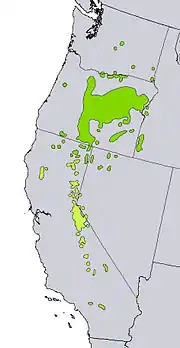 | |
| Natural range in light green (dark green is Juniperus occidentalis) | |
| Synonyms | |
|
Juniperus occidentalis var. australis (Vasek) A.H. Holmgren & N.H. Holmgren | |
Description
Juniperus grandis is a medium-sized tree, growing to 12–26 metres (39–85 feet) tall. It has a stout trunk with red-brown bark, growing up to 3 m (10 ft) in diameter.[1]
The whorled leaves are scale-like and closely appressed. Most plants are dioecious, but about 5–10% are monoecious.[1]
Its fleshy and berry-like cones are 5–9 millimetres (3⁄16–3⁄8 inch) in diameter.[1] Its pollination period is May and June.[2] The seeds are wingless.
Based on dendrochronological evidence from the 2,675-year-old Scofield Juniper, Sierra junipers are the fourth longest-lived tree species after the Great Basin bristlecone pine, alerce and giant sequoia.[6]
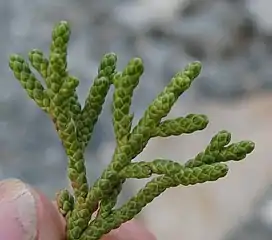 Leaves
Leaves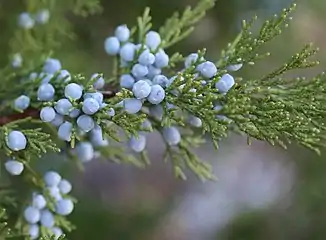 Berry-like cones
Berry-like cones Bark
Bark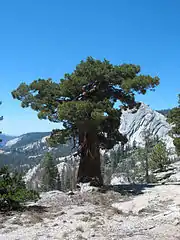 Mature form
Mature form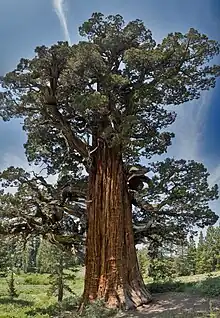 Bennett Juniper, the largest juniper[7]
Bennett Juniper, the largest juniper[7]
Distribution and habitat
Juniperus grandis is native to the Sierra Nevada in eastern California and western Nevada; and the White and Inyo Mountains, San Gabriel and San Bernardino Mountains, and higher elevations of Mojave Desert mountains, in Southern California.[1][2]
It is found in exposed, dry, rocky slopes, flats, pinyon–juniper woodland, and temperate coniferous forest habitats, including the Sierra Nevada upper montane forest and Sierra Nevada subalpine zone ecoregions. It grows at elevations of 100–3,100 m (330–10,170 ft).[1]
References
- Jepson eFlora: Juniperus grandis . accessed 2.2.2017.
- CalFlora: Juniperus grandis
- USDA Plants Profile for Juniperus grandis (western juniper)
- Adams, R. P., S. Nguyen, J. A. Morris and A. E. Schwarzbach. 2006. Re-examination of the taxonomy of the one-seeded, serrate leaf Juniperus of southwestern United States and northern Mexico (Cupressaceae). Phytologia 88(3):299-310.
- "Juniperus grandis R.P.Adams". Plants of the World Online. Royal Botanical Gardens Kew. Retrieved 9 July 2019.
- "OLDLIST, a database of old trees". Rocky Mountain Tree-Ring Research. Retrieved 2021-10-17.
- "Juniperus grandis". Gymnosperm Database. 2020-01-17. Retrieved 2021-10-17.